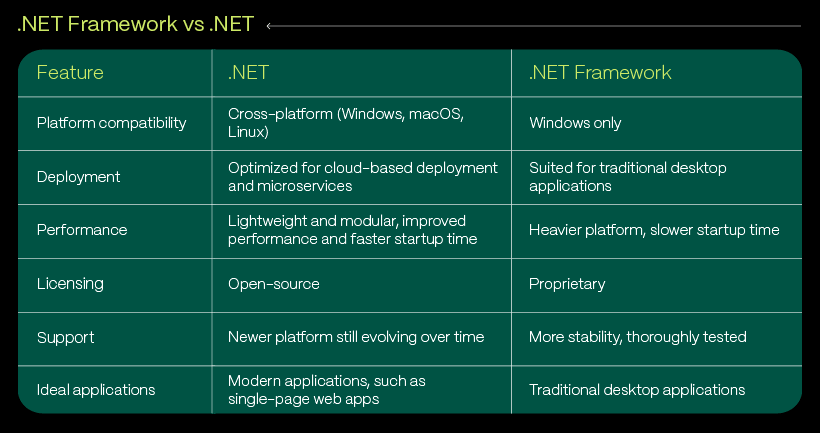Choosing Between .NET Framework And .NET — Which Is Best?

Microsoft's .NET Framework has been one of the most popular and productive tools available to developers for the last two decades. Today, the .NET toolset covers such a diverse array of use cases and projects that the terminology and naming conventions be hard to track. There's .NET Framework, .NET Core, ASP.NET, ASP.NET Core, and plain old .NET available to choose from. So, what tools do we deploy in our teams and which of these tools should you pick for your next project?
Firstly, terminology. .NET Framework is a widely deployed and highly popular tool that many experienced developers will have had some exposure to over their careers. First released in 2002, .NET Framework is a Windows application framework that promotes building secure, type-safe applications using Microsoft's in-house programming languages and development tools. Today, the .NET Framework remains one of the most reliable and capable tools in creating Windows desktop applications.
In comparison, .NET Core is a modernized cross-platform, open-source version of the framework released by Microsoft in 2016. More recently, in 2020, .NET Core has been re-branded as simply .NET with the original .NET Framework being gradually phased out as the company's flagship technology platform.
Knowing the differences in terminology and use between these platforms can be critically important to future projects — as is understanding when each technology will work best for any given use case. Each project has relative strengths and weaknesses that make them ideally suited to different kinds of projects.
Here, we take a look at .NET vs .NET Framework and analyze the technologies and resources that go into developing each. We use our practical experience building bespoke apps to find the best route to take for your next application.
What is .NET?
The first announcement of .NET Core back in 2014 was notable for unveiling cross-platform support for .NET technologies — something that was a bit of a revolution at the time. The technology was designed and built to streamline and simplify the highly effective and productive tools that make up the .NET Framework. Doing this well has allowed .NET Core to become the foundation of a much broader open-source .NET platform encompassing more technologies and use-cases than .NET Framework could have targeted.
Since then, ASP.NET Core has also extended .NET tooling with open-source tools for building applications and services for the web. GUI tools such as Windows Forms and Windows Presentation Foundation (WPF) have been replaced by Universal Windows Platform (UWP) for new Windows-based applications.
Recent versions of .NET have also introduced the Multi-platform App UI (MAUI) to allow developers to create native mobile and desktop apps using C# and XAML.
Remarkably, even as the platform has continually extended its multi-platform capabilities, .NET has maintained a relatively high degree of interoperability with legacy .NET Framework applications.
For teams, this has lowered the barrier of entry to .NET considerably and allowed for production applications to be modernized in a cost-effective way.
The .NET Ecosystem
The biggest piece of common infrastructure between .NET Framework and .NET is the .NET Standard library — a uniform set of APIs available to developers across both implementations.
By targeting .NET Standard 2.0 developers can seamlessly migrate code between both versions of the technology with relative ease. Over time these calls are likely to be replaced by calls to the more modern .NET libraries available to developers. Having the .NET Standard library available as a common interface between platforms makes it considerably easier for developers to inter-change between the two technologies.
In addition to desktop, web, and mobile platforms mentioned here, the broad foundation that .NET has built now extends as far as cloud, console gaming, IoT, and machine learning technologies that power AI services. Utilizing .NET infrastructure such as the common language specification, common language runtime, compilers, and runtime components allows developers to readily expand into new areas of development with a common set of tools, knowledge, and code that serves multiple platforms.
The .NET Framework Today
The .NET framework has long been a key tool in creating Windows desktop, server-based, and web applications to meet a broad base of users. When first introduced it came as a paradigm shift in introducing language-independent features that included type safety, portability with the Windows-based ecosystem, and memory management for .NET Framework applications.
The technology is still widely appreciated for its exceptional long-term stability and support that's die to be continued into the next version of Windows and beyond. Additionally, .NET Framework is still a highly performant, secure, and reliable foundation for many production applications.
When planning future maintenance or extending an application with new features and functionality it's worth carefully examining which technology to lean on and where to rely on tried and tested code over re-writing from the ground up.
When to Choose .NET Framework for Development
.NET Framework saw its final full release rolled out in late 2022. The project has now been moved into a long term stability phase where future modifications and additions will only improve security and reliability.
- Some of the key reasons to deploy or maintain a .NET Framework application include:
.NET Framework is still well within Long Term Support. While no new features will be coming to the framework the regular monthly security and reliability updates will continue as normal — meaning there's no need for an emergency migration. - Existing applications can be extended in the short to mid-term with services targeting .NET libraries. The recommended route to migrating from .NET Framework to .NET includes writing new features and functions to target .NET code.
- Applications with a heavy reliance on third-party libraries not available on .NET will have difficulty. While this problem is becoming increasingly rare, there are still some packages that haven't transitioned to .NET support. It may take some time to find alternative solutions or wait for a .NET implementation.
- Similarly, there are .NET Framework technologies that don't have .NET counterparts. A handful of .NET Framework libraries aren't yet available in .NET, these include AppDomains, Remoting, and Code Access Security among others. While alternate solutions can sometimes be sought out there's often no way to replace some features and code that .NET framework can do very, very well.
Since .NET Framework has a prominent role in the Windows operating system in both Windows 10 and 11 the technology is guaranteed to receive security and reliability updates for several years to come — a reliability boost that application developers can really depend on.
When to Choose .NET
As a modern tool with all the benefits of today's architecture and resources .NET can offer some distinct advantages for application development. Some of the key reasons that teams may choose to adopt .NET development includes:
- Cross-platform capability. One of the most notable advantages of .NET is its ability to build applications that run across Windows, macOS, and Linux.
- Improved cloud deployment. Taking advantage of a paradigm shift in modern technologies, .NET is better optimized for cloud deployment providing better scalability and outright performance for applications with cloud features.
- Improved overall application performance. .NET features faster startup time and improved benchmark results in comparison to .NET framework applications.
- Open Source licensing. .NET is released as an open source project with broad community backing and many user contributions. Developers can contribute code back to the project and teams can benefit from a wider array of licensing options.

Choosing Between .NET Framework vs .NET
Both of these tools are capable of providing robust and reliable applications for teams. Choosing the best solution depends on many detailed questions about your project.
- Is the project safety critical? Should application errors be avoided at any and all costs?
- Who will use the product and what interface do they expect to see?
- What are the longevity requirements of the project?
- How is the product likely to evolve in the future?
These are some of the first questions our dedicated development teams will look to answer when considering the technologies and requirements for any new app. For an insider insight into choosing between .NET framework and .NET for your specific application, a guide on where to start with either technology, or advice on development strategy get in touch with our teams to find out how we build industry-leading software daily.


